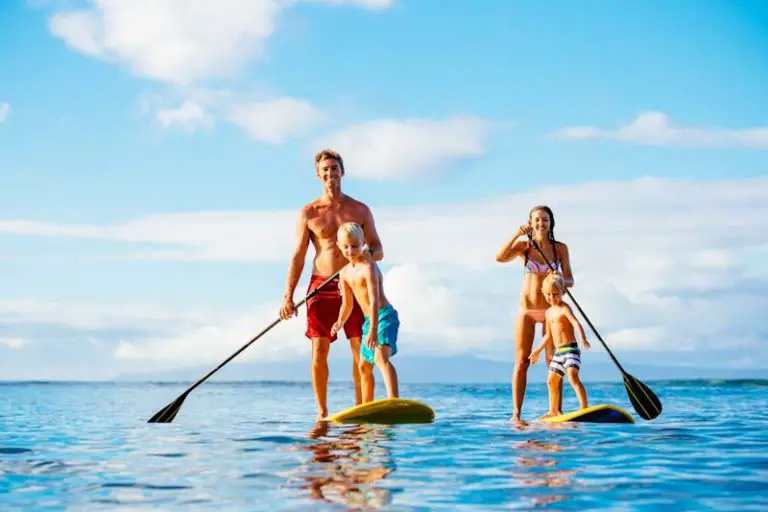Why Are SUP Paddles Angled? We Find Out!
Standup paddleboarding (SUP) paddles have a wide range of available angles for efficiency in paddling on open water. Most of the time, it varies from 5 to 15 degrees. Some paddler enthusiasts are confused about this matter and wonder why are SUP Paddles angled in the first place.
SUP paddles are angled to push the water down during a stroke. This downward thrust helps to slightly lift the paddleboard up out of the water, which reduces friction, enabling easier and more efficient forward motion.

Why Is A Sup Paddle Bent?
A SUP paddle is bent in order to increase the efficiency of every stroke. Because of this, paddlers will require minimal energy and effort since the blades are bent forward. A bent or angled SUP paddle will increase a paddleboarder’s enjoyment and help increase speed while eliminating exhaustion.
SUP paddles come in different shapes and sizes. More so, keen paddlers can find 1-piece, 2-piece, and 3-piece paddles. Paddles come in pieces to be easier to pack and store.
Paddle Sections
- T-Bar Grip: This design fits your hand comfortably. It has an ergonomic top on its paddle.
- Throat: It is where the blade and shaft meet, and along the process, it widens out to maximize your paddling strokes.
- Paddle Shaft It is a rod-like section of the SUP paddle. It’s where you place your hand for a balanced stroke.
- Blade: It’s a finlike design that enables you to stroke under the water and goes with the currents smoothly and efficiently.
- Tip: The end of the blade allows water to pass under it.
This is a tried and true design that takes into account the physics of how a paddle blade moves through the water. The scale features below the T-bar let you adjust the paddle based on its desired length. In this way, paddlers can conveniently enjoy water activities without height or length problems caused by non-adjustable paddles.
Since you know how paddles piece together, it’s crucial to distinguish their sections. You will not have a hard time finding the perfect paddles for your water sports and optimizing your paddling strokes.
Paddling Magazine posted a YouTube video about the benefits of a bent shaft kayak paddle and its effectiveness in navigating water without extraneous activities. Check out the video below.
Which Way Should A SUP Paddle Face?
Typically, you position SUP paddles downward with the angle pointing forward at the bottom. So rather than scooping water with the paddle, you are pushing the water back and downward. While pulling the paddle through the water, your board will slightly lift up reducing friction with the water and enabling you to move forward seamlessly.
How Do You Hold A SUP Paddle?
The ideal way to hold a SUP paddle is to angle it outwards from your body. It keeps you safe from potential harm from the blade’s edge and is more comfortable over time as compared to holding the paddle straight up and down.
Once you have positioned the blade perfectly, you can lean forward and place your power on the shaft of your paddle to move you forward through the water.
How Do You Hold A Curved Paddle Board Paddle?
To know which is which when it comes to handling curved paddles, remember the position of your arms and where they should go, and how your hands are holding the shaft and bar.
So, which arm goes to the top of a SUP paddle? The Paddle Camp recommends that your upper hand should be on the opposite side of the board you’re paddling. Thus, allowing you to create the most thrust as you move the paddle through the water.
As for hand position, it is essential to understand that hand positions help maximize your strokes while minimizing exhaustion and effort. Your hands should not be close together because if they are, then your power distribution is uneven and unbalanced.
Also, your hands should not grip the paddle too tightly; instead, you should relax your hands to increase comfort and control. The more your hands are constricted with tight grips; the more your hands will feel cramps and sore muscles. That’s why it’s best to hold the T-bar and shaft lightly.
Now that arms and hands are in the right spot, it’s then imperative to engage the core muscles during the stroking motion. The core muscle groups mainly used in paddling include the stomach and obliques. Most of your paddling power comes from your core muscles.
Consequently, the stronger your core, the more easily you can propel yourself forward. The technique here is to twist and pull when paddling, as you have to move your waist to move forward somewhat and make swifter strokes.
So keeping your core muscles strong in between paddling trips will further increase your enjoyment when out on the water.
Why Are SUP Paddles Angled – Wrapping up
SUP paddles are angled in order to push the water downwards and back during each stroke. Angled paddles help reduce the friction of the board against the water and provide the most efficient way to create forward motion on a paddleboard.



